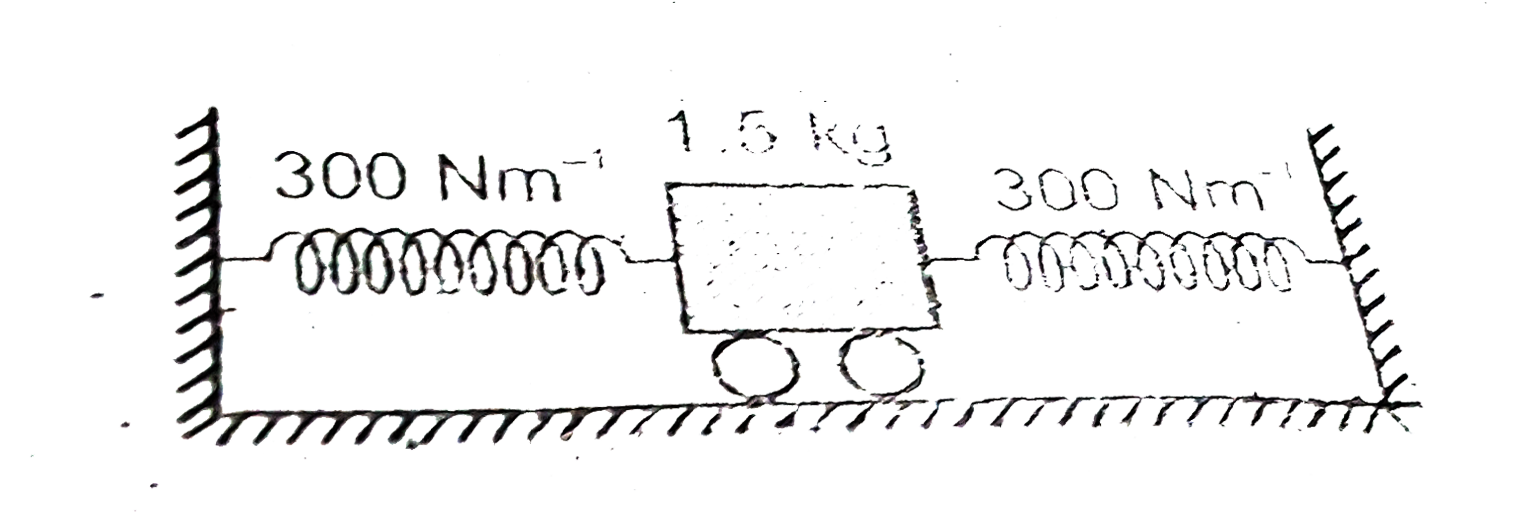A 5 kg collar is attached to a spring of spring constant 500Nm−1 . It slides without friction over a horizontal rod. The collar is displaced from its equilibrium position by 10 cm and released. Calculate (a) The period of oscillations (b) The maximum speed and (c) maximum acceleration of the collar.
To solve the problem step by step, we will calculate the period of oscillation, maximum speed, and maximum acceleration of the collar attached to the spring.
Given Data:
- Mass of the collar, m=5kg
- Spring constant, k=500N/m
- Displacement from equilibrium (amplitude), A=10cm=0.1m
(a) Calculate the Period of Oscillation
The formula for the period of oscillation T of a mass-spring system is given by:
T=2π√mk
Substituting the given values:
T=2π√5kg500N/m
Calculating the fraction:
5500=0.01
Now substituting back into the formula:
T=2π√0.01=2π×0.1=0.2π
Calculating 0.2π:
T≈0.628s
(b) Calculate the Maximum Speed
The maximum speed vmax can be calculated using the formula:
vmax=ωA
Where ω (angular frequency) is given by:
ω=2πT
Substituting the value of T:
ω=2π0.628≈10rad/s
Now substituting ω and A into the maximum speed formula:
vmax=10rad/s×0.1m=1m/s
(c) Calculate the Maximum Acceleration
The maximum acceleration amax can be calculated using the formula:
amax=ω2A
Substituting the values:
amax=(10rad/s)2×0.1m=100×0.1=10m/s2
Final Answers:
- (a) The period of oscillation T≈0.628s
- (b) The maximum speed vmax=1m/s
- (c) The maximum acceleration amax=10m/s2
- Mass of the collar, m=5kg
- Spring constant, k=500N/m
- Displacement from equilibrium (amplitude), A=10cm=0.1m
- (a) The period of oscillation T≈0.628s
- (b) The maximum speed vmax=1m/s
- (c) The maximum acceleration amax=10m/s2
Topper's Solved these Questions
Similar Questions
A 2.5 kg collar is attached to a spring of spring constant 250Nm−1 . It slides without friction over a horizontal surface . It is displaced from its equilibrium position by 20 cm and releasd. Calculate the period of osciallation and the maximum speed.
View SolutionA 2.5 kg collar attached to a spring of foce constant 1000 Nm−1 slides without friction on a horizontal rod. The collar is displaced from its equilibrium position by 5.0 cm and released. Calculate (i) the period of oscillation (ii) the maximum speed of the collar and (iii) the maximum acceleration of the collar.
View Solution
Knowledge Check
A 5 kg collar is attached to a spring of spring constant 500 N m−1. It slides without friction over a horizontal rod. The collar is displaced from its equilibrium position by 10 cm and released. The time period of oscillation is
Aπ5sBπ2sCπsD2πs
A 10 kg collar is attached to a spring of spring constant 1000Nm−1 . It slides without friction over a horizontal surface. If is displaced from its equilibrium position by 20 cm and released . Calculate
(a) The period of oscillation (b) The maximum speed
Hint :T=2π√mk,vm=Aω=A√km
View SolutionA 5kg collar is attached to a spring . It slides without friction over a horizontal surface. It is displaced from its equilibrium position by 10 cm and released , its maximum speed is 1ms−1 Calculate
(a) Spring constant
(b) The period of oscillation
(c ) Maximum acceleration of the collar
Hint :m=5kg,A=0.1m,k=?,T=?or a=?,vm=1ms−1
vm=Aω=A√km
Find k,
T=2π√mk
amax=ω2A=kmA
View SolutionA 4 kg roller is attached to a massless spring of spring constant k = 100 N/m. It rolls without slipping along a frcitionless horizontal road. The roller is displaced from its equilibrium position by 10 cm and then released. It rolls without slipping along a frictionless horizontal road. The roller is displaced from its equilibrium position by 10 cm and then released. Its maximum speed will be
View SolutionA trolley of mass 3.0kg is connected to two identical spring each of force constant 600Nm−1 as shown in figure. If the trolley is displaced from its equilibrium position by 5.0 cm and released, what is
(a) the period of ensuing oscillation?
(b) the maximum speed of trolley?
(c) How much is the total energy dissipated as heat by the time the trolley comes to rest due to damping forces?

View SolutionA mass of 1.5 kg is connected to two identical springs each of force constant 300Nm−1 as shown in the figure. If the mass is displaced from its equilibrium position by 10cm, then the period of oscillation is

View SolutionA block of mass m hangs from a vertical spring of spring constant k. If it is displaced from its equilibrium position, find the time period of oscillations.
View SolutionA 10 kg metal block is attached to a spring constant 1000Nm−1. A block is displaced from equilibrium position by 10 cm and released. The maximum acceleration of the block is
View Solution
